Thanks @Peter_P and @dark cloud for confirming my understanding that the extended hose doesn’t terminate downward enough to directly drain to the ground. I think the DIY done by @beastman is the correct way. Unsurprisingly, the Tesla's extension method looks like a haphazard job to me and that they like to deposit the drainage, if not directly at the components, but somewhere near them and eventually on the top of the bottom tray at best !!! And here we are complaining about the early model S cars ... look at the AC drain line of Model 3. No lesson learned.
Welcome to Tesla Motors Club
Discuss Tesla's Model S, Model 3, Model X, Model Y, Cybertruck, Roadster and More.
Register
Install the app
How to install the app on iOS
You can install our site as a web app on your iOS device by utilizing the Add to Home Screen feature in Safari. Please see this thread for more details on this.
Note: This feature may not be available in some browsers.
-
Want to remove ads? Register an account and login to see fewer ads, and become a Supporting Member to remove almost all ads.
You are using an out of date browser. It may not display this or other websites correctly.
You should upgrade or use an alternative browser.
You should upgrade or use an alternative browser.
Vendor Preventative Maintenance regarding Battery Failures in early Model S vehicles (2012-2014)
- Thread starter wk057
- Start date
That's what I am wondering too... I have a hunch I posted about earlier where I believe the 80A L2 chargers at home may do a better job at drying out the pack on a weekly basis to prevent the corrosion death of the bms on the battery. This is only anecdotal information; but I know of at least one member here who has 353k original miles w/ an 80a charger on his battery and another one over 200k w/ 80a. Most of the P85+ cars have the dual chargers too. Supercharging definitely has to cool the batteries down and thus should shed some heat into the surrounding area as you can hear the coolant pump circulate during the top-off and speed up the flow.I have a 2014 85s. Would taking the car for a long trip with supercharging evaporate moisture in the battery pack?
I want to run a survey w/ google surveys and see if we can find a correlation to long lasting original packs w/ primarily those supercharging weekly or l2 80a charging. I have a mobile connector 40a and I don't hear the coolant pump run at all and it usually wants to go down to 30a... the mobile connector is 9 years old. I have a wall connector being installed today (48a) on a 60a breaker and will see if this changes any of the behavior during top-off.
Ron Burgundy
Member
Kaveman,Did a re-route of the drain today after reading this thread. My pack was replaced in 2020, but the SC did not change out the drain pipe. Here in FL the evaporator sweats alot! Glad to get that water off of the battery... What a design!
another $.02
Kaveman
Great info. I just got into it this evening, and I appear to have the same battery set-up and small drain hose that you have.
Do you remember:
1. What size elbow ends (same on each?)
2. What size and length of extension tubing you used?
In your second pic it is hard to see where it comes out, any additional info?
Thanks in advance!
Hi,Kaveman,
Great info. I just got into it this evening, and I appear to have the same battery set-up and small drain hose that you have.
Do you remember:
1. What size elbow ends (same on each?)
2. What size and length of extension tubing you used?
In your second pic it is hard to see where it comes out, any additional info?
Thanks in advance!
I got some PEX 1/2 x 1/2 Elbows and some Vinyl Hose(small spool 1/2 OD) at the Depot. Used a hose clamp to make sure it doesn't leak from the original drain as it is 5/8 ID(I think). Routed around the "penthouse" and an elbow out behind the rear of the front suspension. The piece going down from the second elbow is just long enough to clear the battery box, but not hanging down too far to catch anything going down the road. Hope that made sense.
Kaveman
Ron Burgundy
Member
Yes, it makes sense.Hi,
I got some PEX 1/2 x 1/2 Elbows and some Vinyl Hose(small spool 1/2 OD) at the Depot. Used a hose clamp to make sure it doesn't leak from the original drain as it is 5/8 ID(I think). Routed around the "penthouse" and an elbow out behind the rear of the front suspension. The piece going down from the second elbow is just long enough to clear the battery box, but not hanging down too far to catch anything going down the road. Hope that made sense.
Kaveman
What do you estimate the total length of the new extension hose was? I am guessing 4' or less?
Yes I'd say 3-4 ft at mostYes, it makes sense.
What do you estimate the total length of the new extension hose was? I am guessing 4' or less?
dark cloud
Active Member
Well, it is a little too late for any preventative maintenance for my pack, as I'm getting a "new" one. I conclude it was not the HVAC drain tube that caused it, as I had the long extended one, so might have been the side vents allowing moisture, or perhaps something else, we'll never know.
Well, it is a little too late for any preventative maintenance for my pack, as I'm getting a "new" one. I conclude it was not the HVAC drain tube that caused it, as I had the long extended one, so might have been the side vents allowing moisture, or perhaps something else, we'll never know.
Wow, how did your pack fail all of the sudden? Would you elaborate a bit more?
dark cloud
Active Member
I put some info here, don't want to hijack this thread: Here is a more appropriate thread for my issue: BMS_w035Wow, how did your pack fail all of the sudden? Would you elaborate a bit more?
Ron Burgundy
Member
I was able to replicate what Kaveman did as I have a Signature (85K), RWD. I used a heater hose, 1/2", along with a 1/2" elbow to go from the short tube to the heater hose (just like in Kaveman's pics). A 3' length is all that is needed. I used two 1/2" band clamps on either side of the elbow. The heater hose bent nicely around the battery pack housing, and then again down and out to drain below the batter shield onto the ground.Yes I'd say 3-4 ft at most
Additionally, on the other side of the firewall is where the coolant tank is located. I noticed it has a 5/16" pressure relief exit barbed nipple that is just there in case of the coolant going above max pressure. I essentially did the same hose routing, using a 5/16" washer fluid hose to go down and out below the battery shield below the car. My guess is that it would be very rare that the coolant would get to a point where it would use the relief valve/nipple, but if it does, it would just spray all over the firewall area. Now it will go down and out. Also used a small band clamp to keep it on the nipple.
Attachments
-
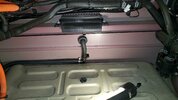 20220928_175904.jpg316.5 KB · Views: 291
20220928_175904.jpg316.5 KB · Views: 291 -
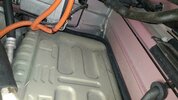 20220928_175913.jpg317.2 KB · Views: 139
20220928_175913.jpg317.2 KB · Views: 139 -
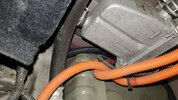 20220928_180053.jpg448.5 KB · Views: 133
20220928_180053.jpg448.5 KB · Views: 133 -
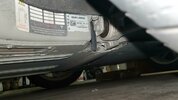 20220928_180001.jpg258.5 KB · Views: 137
20220928_180001.jpg258.5 KB · Views: 137 -
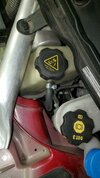 20220928_173524.jpg330.5 KB · Views: 132
20220928_173524.jpg330.5 KB · Views: 132 -
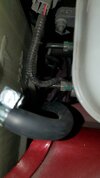 20220928_173535.jpg194.5 KB · Views: 126
20220928_173535.jpg194.5 KB · Views: 126 -
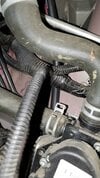 20220928_173553.jpg384.3 KB · Views: 118
20220928_173553.jpg384.3 KB · Views: 118 -
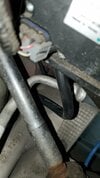 20220928_173559.jpg255 KB · Views: 123
20220928_173559.jpg255 KB · Views: 123 -
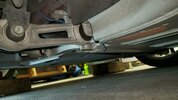 20220928_173616.jpg293.3 KB · Views: 149
20220928_173616.jpg293.3 KB · Views: 149
Ron Burgundy
Member
That is a good point. I am not sure what the temps would be for the event to happen. Maybe someone else knows?@Ron Burgundy - Nice job. Not sure how hot the battery case would get during summer time and by the heat generated by the pack itself, but I'm wondering if the extension line would handle such a possible heat.
Back in the old days, when they didn't have coolant tanks (like my 1970 Torino GT Conv), they just used the same type of tube off of the radiator filler neck to vent the coolant down and onto the road when the spring load pressure of the cap reached it's limit.
I doubt the front portion of the vehicle will reach anywhere near 85c (185f), those temperatures are normal in an ICE vehicle under the hood. Most honda's have 180F thermostats and most everything under the hood of an ice vehicle is rated for at least 105c (221F). The battery case and a/c compressor under the hood are the only two items to my knowledge which could generate heat besides a coolant pump. I seriously doubt the battery will reach even over 130F temps; but others here like wk057 will have more insight into this. Any hose rated for heater hose should handle at least 90c (194F) and will likely handle upwards of 125c (257F). I don't think there will be a problem w/ the a/c drain line extension material used here.
I doubt the front portion of the vehicle will reach anywhere near 85c (185f), those temperatures are normal in an ICE vehicle under the hood. Most honda's have 180F thermostats and most everything under the hood of an ice vehicle is rated for at least 105c (221F). The battery case and a/c compressor under the hood are the only two items to my knowledge which could generate heat besides a coolant pump. I seriously doubt the battery will reach even over 130F temps; but others here like wk057 will have more insight into this. Any hose rated for heater hose should handle at least 90c (194F) and will likely handle upwards of 125c (257F). I don't think there will be a problem w/ the a/c drain line extension material used here.
Good info on the heat ratings. I was more curious if the hose happens to be in direct contact with and resting on the case. Would the ratings you have listed still handle it?
GTi_roadkill
Member
Curious if you see any puddles in your driveway or garage now that the AC drains ‘properly’I was able to replicate what Kaveman did as I have a Signature (85K), RWD. I used a heater hose, 1/2", along with a 1/2" elbow to go from the short tube to the heater hose (just like in Kaveman's pics). A 3' length is all that is needed. I used two 1/2" band clamps on either side of the elbow. The heater hose bent nicely around the battery pack housing, and then again down and out to drain below the batter shield onto the ground.
Additionally, on the other side of the firewall is where the coolant tank is located. I noticed it has a 5/16" pressure relief exit barbed nipple that is just there in case of the coolant going above max pressure. I essentially did the same hose routing, using a 5/16" washer fluid hose to go down and out below the battery shield below the car. My guess is that it would be very rare that the coolant would get to a point where it would use the relief valve/nipple, but if it does, it would just spray all over the firewall area. Now it will go down and out. Also used a small band clamp to keep it on the nipple.
Plasmid_Boy
Member
Checked my 2014 P85+ and relieved to see the drain hose is extended over the penthouse.

Checked my 2014 P85+ and relieved to see the drain hose is extended over the penthouse. View attachment 859425
Great. Would you share the build month in 2014 and your VIN being below or above 70k? Tnx.
Plasmid_Boy
Member
Sure. September 2014, vin 51k.Great. Would you share the build month in 2014 and your VIN being below or above 70k? Tnx.
Sure. September 2014, vin 51k.
Would you happen to think that the extension was installed at the factory when the car was built and not by a service center as a correction action? If you are the first owner you definitely would know.
Thanks again.
Similar threads
- Replies
- 3
- Views
- 389
- Replies
- 25
- Views
- 1K
- Replies
- 17
- Views
- 1K
- Replies
- 21
- Views
- 4K
- Replies
- 51
- Views
- 2K


